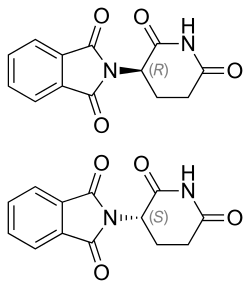Thalidomide example

Stereochemistry has important applications in the field of medicine, particularly pharmaceuticals. An often cited example of the importance of stereochemistry relates to the thalidomide disaster. Thalidomide is a pharmaceutical drug, first prepared in 1957 in Germany, prescribed for treating morning sickness in pregnant women. The drug was discovered to be teratogenic, causing serious genetic damage to early embryonic growth and development, leading to limb deformation in babies. Several proposed mechanisms of teratogenicity involve different biological functions for the (R)- and (S)-thalidomide enantiomers. [3] In the human body, however, thalidomide undergoes racemization: even if only one of the two enantiomers is administered as a drug, the other enantiomer is produced as a result of metabolism. [4] Accordingly, it is incorrect to state that one stereoisomer is safe while the other is teratogenic. [5] Thalidomide is currently used for the treatment of other diseases, notably cancer and leprosy. Strict regulations and controls have been implemented to avoid its use by pregnant women and prevent developmental deformities. This disaster was a driving force behind requiring strict testing of drugs before making them available to the public.
In yet another example, the drug ibuprofen can exist as (R)- and (S)-isomers. Only the (S)-ibuprofen is active in reducing inflammation and pain. [6] [7]






